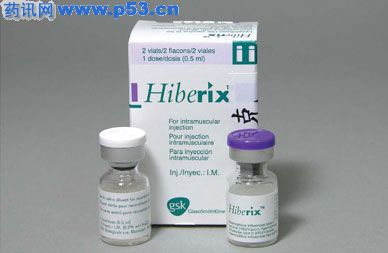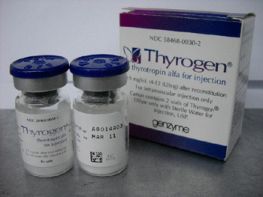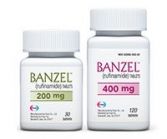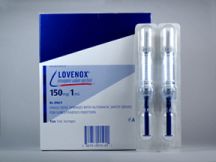|

适应症:Hiberix适用于二个月大以上婴儿的主动免疫反应,以预防B型流行性感冒嗜血杆菌所引起的疾病。
剂量:
1、 基础疫苗接种时间为于出生后的六个月内接种二剂。为确保产生长期的保护作用,建议于出生后的第二年追加一剂。
2、六至十二个月大间的婴儿,若先前未曾接种过此疫苗,则应间隔一个月接种两剂,并于出生后的第二年追加一剂。一至五岁,先前未曾接种过此疫苗的儿童,应接种一剂。
用法:深部肌肉注射
禁忌症:Hiberix不应用于已知对此疫苗中任何成分过敏者,或先前曾于接种Hib疫苗之后出现过敏征兆者。
注意事项:
1、 与其它疫苗一样,对急性严重发烧性疾病患者,应延后接种Hiberix。但轻度的感染现象则非接种疫苗的禁忌。
2、 Hiberix可与Infanrix(三合一疫苗)一起使用。
3、 本疫苗需自费。
4、 限由医师处方使用。
药师的叮咛:
流行性感冒B型嗜血杆菌引起的上呼吸道感染主要是藉由直接接触或呼吸道吸入病原菌而感染,症状如发烧、头痛、咽喉炎、肌肉酸痛、虚弱等,其感染途径及产生疾病症状与一般常见流行性感冒病毒所引起的类似,一至二岁婴孩感染,严重时会引起脑膜炎,所以一般建议五岁以下的小孩都能施打型嗜血杆菌疫苗。
Hiberix
MIMS Abbreviated PrescribingInformationhaemophilusBconjugatevaccineSmithKlineBeechamPharmaceuticalsSection: 10(a) Vaccines - ImmunologyPregnancyCategory:B2Permitted in sport
Use: Active immunisation against Haemophilus influenzae type b in children 2months-5 yearsContraindications: Acute severe febrile illness;
IVIPrecautions: Immunosuppression; thrombocytopenia, bleeding disorders (SCIrecommended); pregnancy, lactationAdverse Reactions:
Local erythema; fever; loss of appetite; GI upset;
restlessness; unusual crying; others, see MIMS Annual or Supplement
Hiberix (Injection) Rx
Haemophilus influenzae type b purified capsular polysaccharide bound totetanus toxiod 30 mcg; NaCl, lactose; prefilled syringePack 10 mcg/0.5 mL [1]Dose 0.5 mL IMI at 2, 4 and 6 months; booster dose at 18 months. 12months:
anterolateral thigh; > 12 months: deltoid region or anterolateral thighMIMS Annual 1998, Suppl. No. 2, p. 149
HiberixMIMS Full Prescribing InformationSmithKline Beecham International - PharmaceuticalsMIMS revision date: 1/08/1998Composition Active.
Haemophilus influenzae type b capsular polysaccharide.
Inactive. Tetanus toxoid.
Reconstituted vaccine: lactose, sodium chloride, water for injection.
Description Hiberix is a noninfectious vaccine containing purifiedpolyribosylribitol phosphate capsular polysaccharide (PRP) of Haemophilusinfluenzae type b covalently bound to tetanus toxoid.
Hiberix is supplied as a white lyophilised pellet for reconstitution withsterile saline solution 0.9%. Each 0.5 mL dose contains 10 microgram ofpurified capsular polysaccharide of Hib covalently bound to approximately 30microgram of tetanus toxoid.
The Hiberix Hib polysaccharide is extracted from a culture of Haemophiluinfluenzae type b strain 20,752. After activation with cyanogen bromide andderivatisation with an adipic hydrazide spacer, the Hib polysaccharide iscoupled to tetanus toxoid via carbodiimide condensation. After purification,the Hib conjugate is lyophilised in the presence of a lactose stabiliser.
Hiberix meets the World Health Organization requirements for the manufactureof biological substances and Hib conjugate vaccines.Actions Pharmacology.
The protective efficacy of Hiberix has not beenstudied in field trials. Hiberix has however been shown to induce anti-PRPantibodies above the level known to be protective against invasive diseasedue to Haemophilus influenzae type b. An anti-PRP antibody titre greaterthan or equal to 0.15 microgram/mL correlates with immediate protectionagainst Hib infection and greater than or equal to 1.0 microgram/mLcorrelates with long term protection.
The immunogenicity of Hiberix has been investigated in clinical studiesinvolving over 300 infants (over two months of age) using a three doseprimary vaccination schedule. Protective anti-PRP antibody titres weredemonstrated in 95 to 100% (greater than or equal to 0.15 microgram/mL)
and87 to 90% (greater than or equal to 1.0 microgram/mL) of infants one monthafter completion of the primary schedule.
Clinical trials have demonstrated the immunogenicity of Hiberix is unalteredby administration of different primary vaccination schedules. One monthafter completion of a two, four, six month or three, four, five monthprimary schedule, over 95% of infants in each group obtained anti-PRP titresgreater than or equal to 0.15 microgram/mL.A boosting dose of Hiberix was given either separately (n = 19) or incombination with DTPa (n = 56) to infants aged between 15 and 18 months whohad previously received primary immunisation with Hiberix and DTPa given atseparate sites. One month after administration of this booster dose,ananamnesticresponse was observed with anti-PRP antibody titres ofgreaterthan or equal to 0.15 microgram/mL and greater than or equal to 1.0microgram/mL being obtained in 100% and greater than 94% of infantsrespectively.
Indications Active immunisation against Haemophilus influenzae type binfection in children aged from two months to five years.
Contraindications
Known hypersensitivity to any component of the vaccine,or to subjects having shown signs of hypersensitivity after previousadministration of Hib vaccines.
As for any vaccine, Hiberix should not be administered to subjects suffering from acute severe febrile illness. However, the presence of minor infectiondoes not contraindicate vaccination.
Precautions
Hiberix should never be administered intravenously.
It is good clinical practice that any vaccination be preceded by a review ofmedical history (especially with regard to previous vaccinations andpossible adverse events) and a clinical examination.As with all injectable vaccines, appropriate medical treatment andsupervision should always be readily available in case of anaphylacticreactions following the administration of the vaccine.
Native populations (native Alaskans, native American Indians) with a highincidence of Haemophilus influenzae type b disease have shown a reducedantibody response to conjugated Haemophilus influenzae type b vaccines.
Theimmunogenicity of Hiberix has not been studied in the Australian Aboriginalpopulation and the possibility of a lower antibody response than that seenin clinical studies should be borne in mind.
Human immunodeficiency virus (HIV) infection is not a contraindication tovaccination. However an adequate antibodyresponsemaynotbeobtainedinpatientswithanimmunodeficiencydisorderorinpatientsreceivingimmunosuppressive therapy (see Interactions).
Hiberix should be administered subcutaneously in patients withthrombocytopenia or bleeding disorders (e.g. haemophiliacs) since bleedingafter intramuscular injection may occur in these patients (see Dosage andAdministration).Urinary excretion of the capsular polysaccharide antigen has been reportedfollowing Hib vaccination.
Therefore antigen detection within one to twoweeks of vaccination may not be of diagnostic value in suspected Hibdisease.An immune response to the tetanus toxoid component may occur followingHiberix vaccination, however this does not substitute for routine tetanusvaccination.
Hiberix will not protect against diseases caused by other types ofHaemophilus influenzae, or meningitis caused by other organisms.
Use in pregnancy. (Category B2)The effect of Hiberix on fetal development is unknown.
Therefore,vaccination of pregnant women cannot be recommended.
Use in lactation.
The effect of Hiberix in lactation has not been assessed,as the vaccine is not intended for adult use.
Adverse Reactions Clinical trial data. In controlled clinical trials, signsand symptoms were actively monitored for the first four to eight daysfollowing Hiberix vaccination and recorded on diary cards.
The vaccine wasgenerally well tolerated and most local adverse events were considered to bemild and transient. The incidence of local adverse events didnotincreasewith subsequent vaccine doses. As Hiberix was coadministered with either adiphtheria-tetanus-acellular pertussis vaccine or a diphtheria-tetanus-wholecell pertussis vaccine,systemicadverseeventscannotbespecificallyattributed to either vaccine. Most systemic events were mild and resolvedspontaneously.
Events are listed within body systems and categorised by frequency accordingto the following definitions. Very common events reported at a frequency ffgreater or equal to 1/10 patients; common events reported at a frequency ofless than 1/10 but greater or equal to 1/100 patients; uncommon eventsreported at a frequency of less than 1/100 but greater or equal to 1/1,000patients; rare events reported at a frequency of less than 1/1,000 patients.
Local reactions. Very common: redness (> 2 cm). Common: pain, swelling (> 2cm).Body as a whole. Very common: fever. Common: viral infection. Uncommon:asthenia, fatigue, injury.
Dermatological. Common: erythematous rash, injection site reaction.Uncommon: sweating increased, purpura.
Gastrointestinal. Very common: loss of appetite, vomiting, diarrhoea.Common: gastroenteritis. Uncommon: abdominal pain.
Musculoskeletal. Uncommon: spastic paralysis.
Nervous system. Very common: restlessness, unusual crying. Common:nervousness, somnolence. Uncommon: insomnia, emotional lability.Respiratory. Common: rhinitis, coughing, respiratorydisorder,upperrespiratory tract infection, bronchitis.
Special senses. Common: conjunctivitis, otitis media.
No serious adverse event was considered by investigators to be related toHiberix alone. In two serious adverse events considered related or possiblyrelated to vaccination, Hiberix was administered simultaneously with anacellular DTP vaccine.
Postmarketing data. Postmarketing experience with Hiberix is currentlylimited.Interactions Hiberix may be administered either simultaneously, or at anytime before or after different live or inactivated vaccines. However,different injectable vaccines administered concurrently should always begiven in separate sites using separate syringes.
Clinical trials have shown concomitant administration of Hiberix and thediphtheria-tetanus-pertussis (acellular or whole cell) combination vaccinesdoes not affect the immunogenicity of either vaccine, provided the vaccinesare given at separate sites and not mixed prior to administration.As with other vaccines, it may be expected patients receivingimmunosuppressive therapy (e.g. high dose steroids or cyclosporin) orpatients with an immunodeficiency may not achieve an adequate immuneresponse (see Precautions.)Hiberix must not be mixed with other vaccines in the same syringe.
Dosage and Administration Hiberix is supplied as a white lyophilised pelletfor reconstitution with sterile 0.9% saline diluent. Hiberix is prepared byadding the entire contents of the diluent container to the vial containingthe Hib vaccine pellet. The reconstituted solution must be shaken wellbefore use, and must not be injected prior to complete dissolution of theHib pellet. All parenteral drug and vaccine products should be inspectedvisually prior to administration for foreign particulate matter and/ordiscolouration. If either are observed, discard the diluent or reconstitutedvaccine. Afterreconstitution Hiberix should be used promptly or kept inarefrigerator. If it is not used within 24 hours, it should be discardedbecause of the risk of contamination.
The recommended dose is 0.5 mL.Hiberix vaccine must be administered by intramuscular injection. In infantsand children under 12 months of age it is preferable to inject the vaccinein the anterolateral thigh because of the small size of their deltoidmuscle. In children over 12 months of age the injection can alternatively begiven in the deltoid region. The vaccine should be administeredsubcutaneously in patients with thrombocytopenia or bleeding tendencies,e.g. haemophiliacs (see Precautions).Note. Hiberix must not be given intravenously.
The recommended primary vaccination course consists of three doses at two,four and six months of age. A booster dose is recommended at 18 months ofage to ensure long term protection.
This is consistent with the National Health and Medical Research Councilrecommendations for Haemophilus influenzae type b vaccination.
Presentation Prefilled syringe (white pellet with clear, colourless saline0.9% diluent in glass vial): 1's.Storage Store between 2 deg. C to 8 deg. C. Protect from light.
Lyophilised Hib vaccine is not affected by freezing.
Shelf life: 3 years.
The sterile 0.9% saline diluent may be refrigerated or stored at ambienttemperature, but must not be frozen.
Poison Schedule S4.
Date of TGA approval or last amendment 17/02/1998 |







![驱虫斑鸠菊注射液[与维阿敏白灵组合治疗]](/uploadfile/picture/uploadfile/200710/20071014112428638.gif)
![维阿敏白灵[维药口服经典方]](/uploadfile/picture/uploadfile/200710/20071014112154962.gif)
